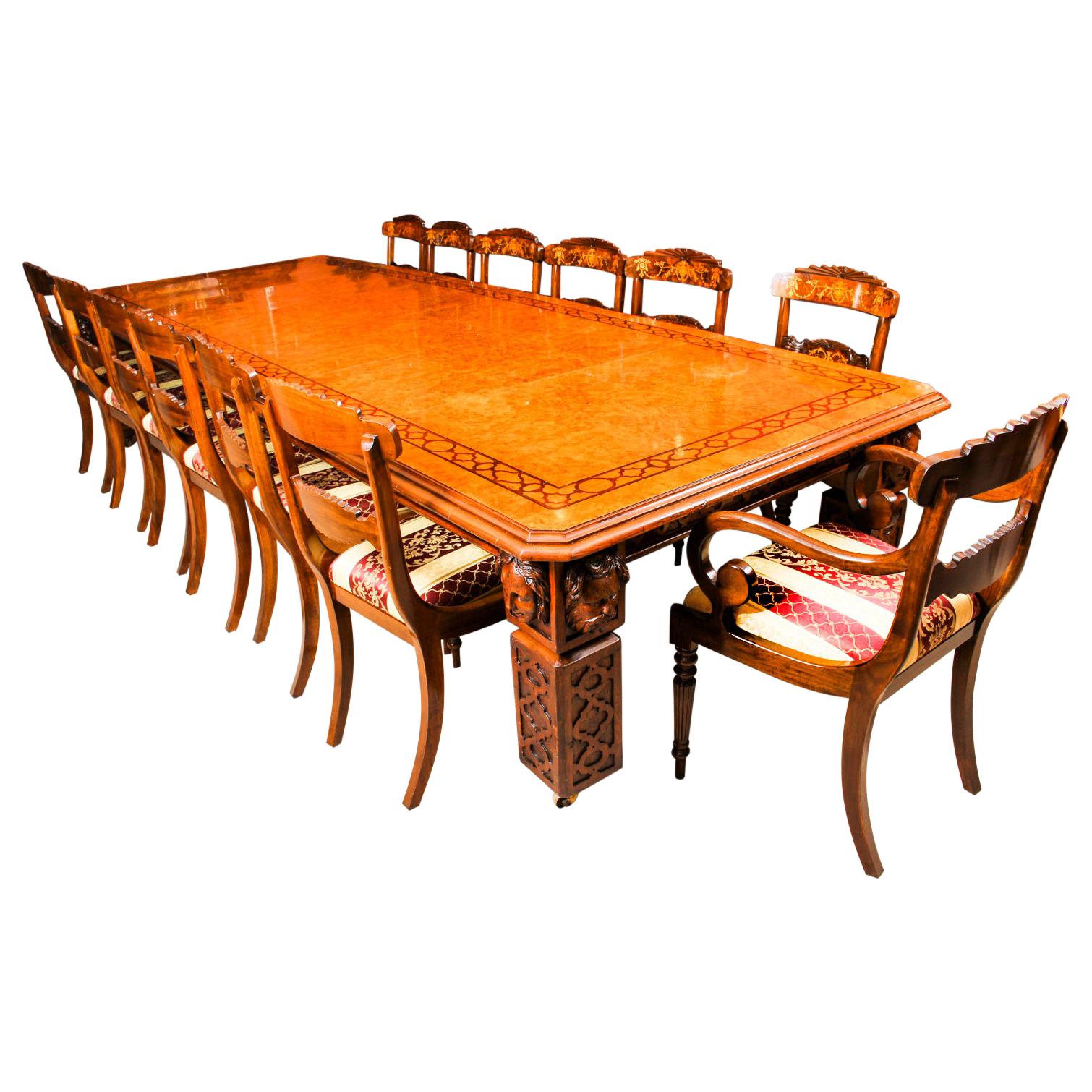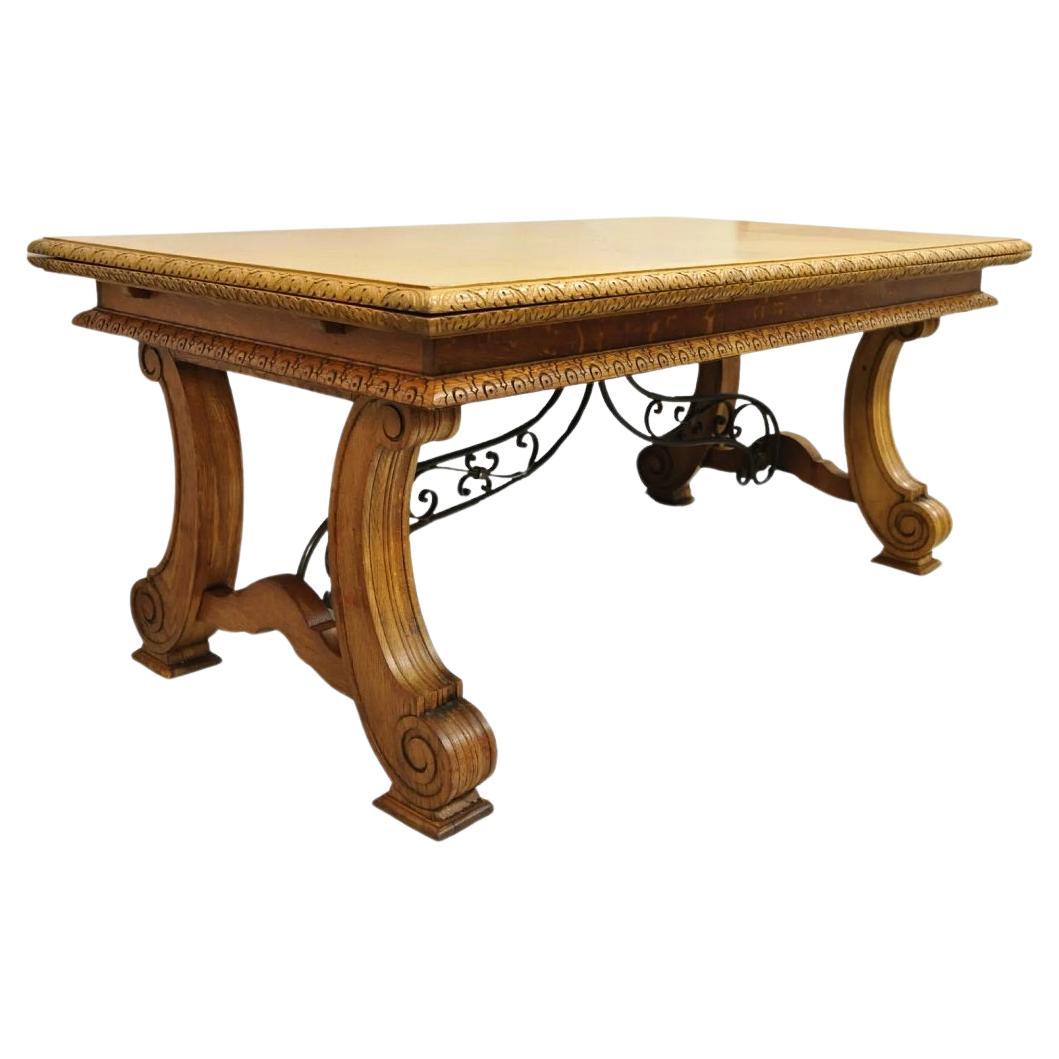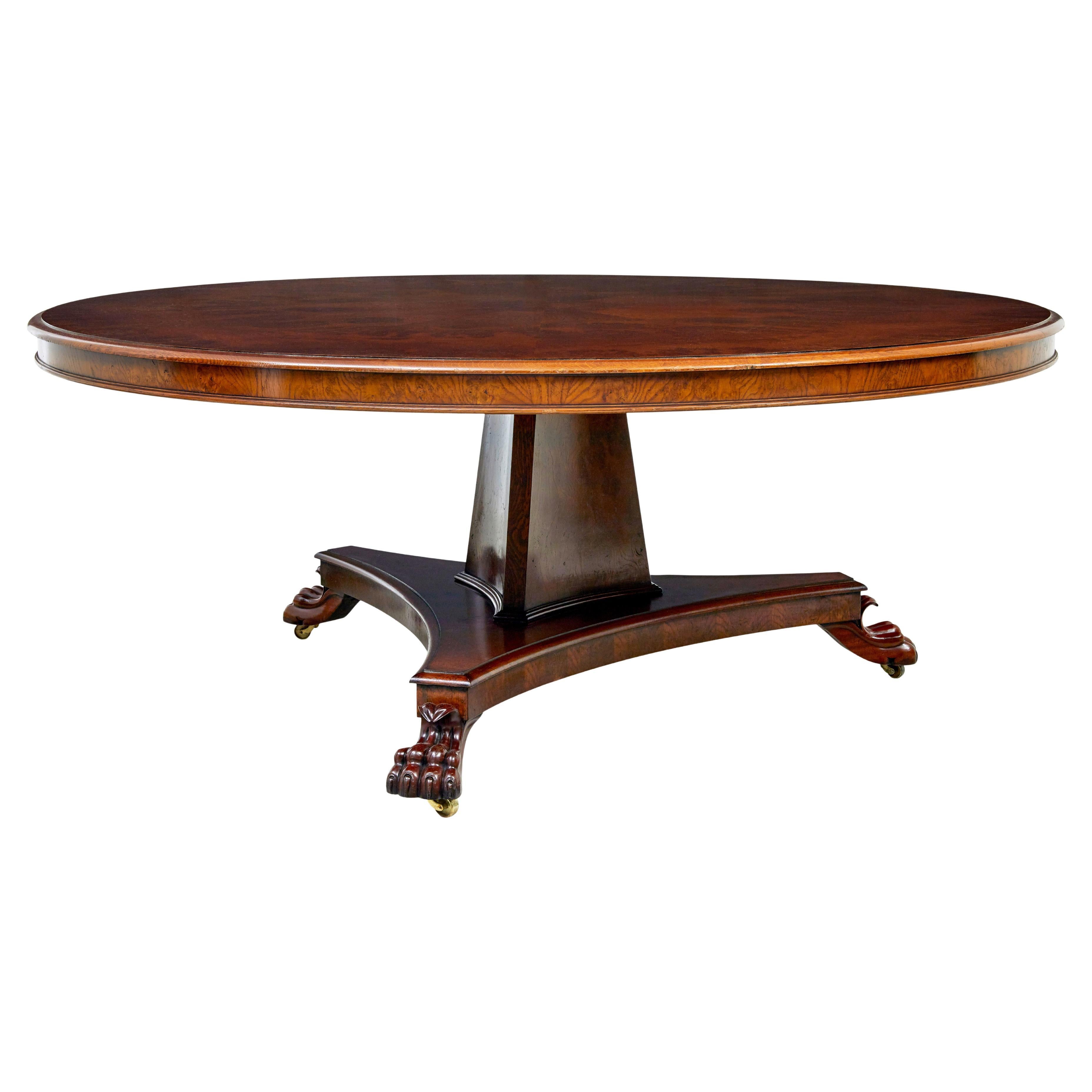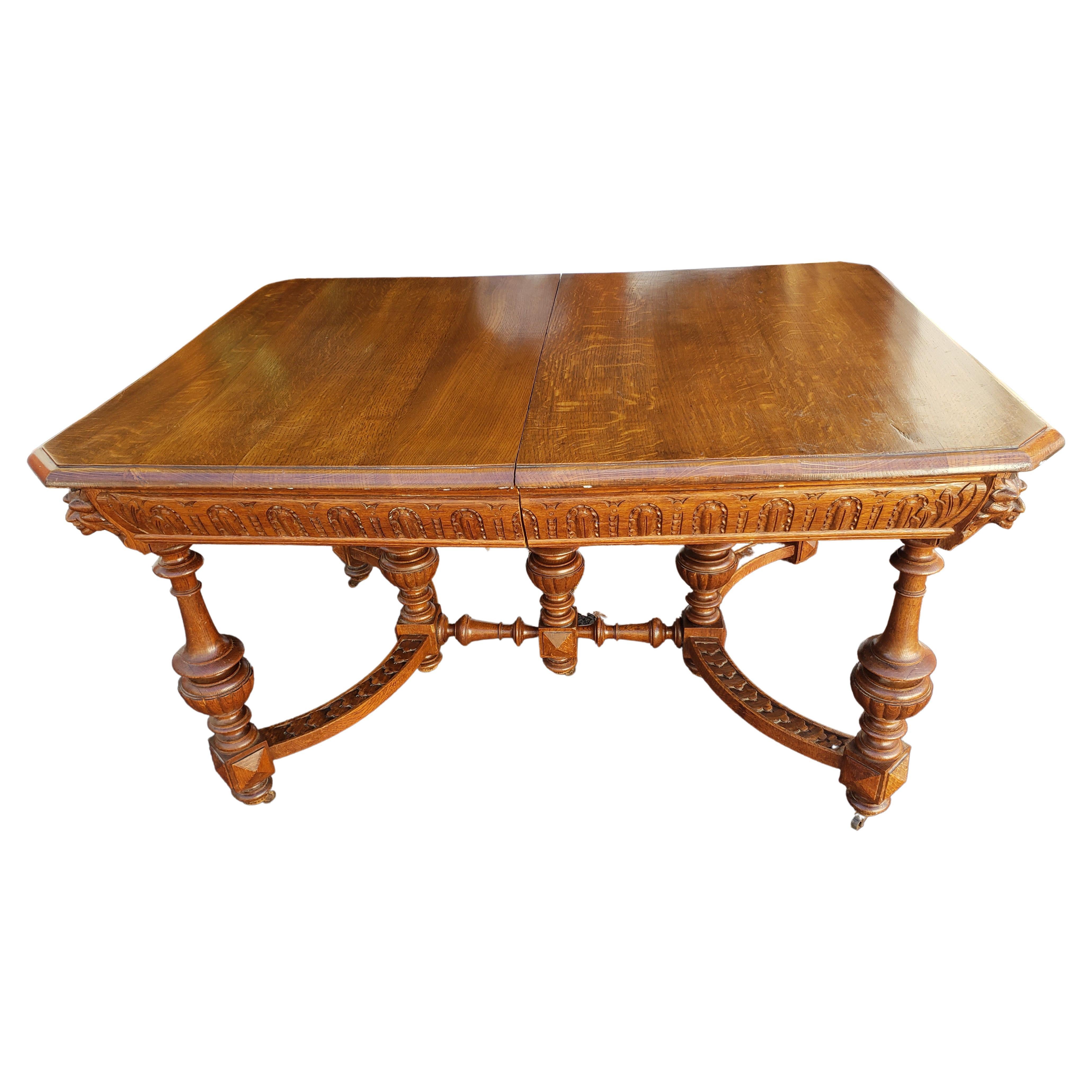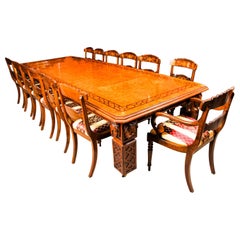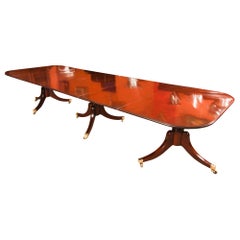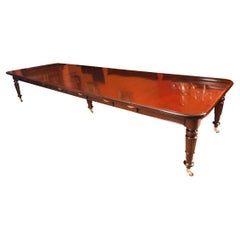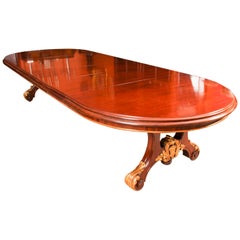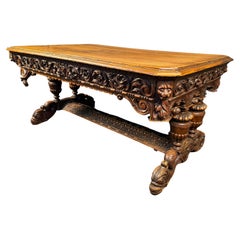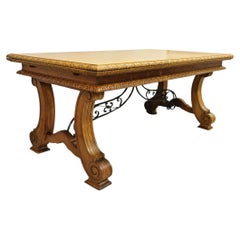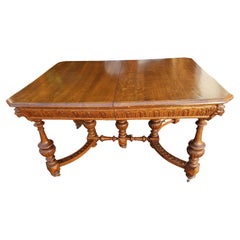Items Similar to Antique Elizabethan Revival Pollard Oak Extending Dining Table, 19th Century
Video Loading
Want more images or videos?
Request additional images or videos from the seller
1 of 22
Antique Elizabethan Revival Pollard Oak Extending Dining Table, 19th Century
$53,625.12
£38,500
€45,527.30
CA$72,997.20
A$81,820.46
CHF 42,601.51
MX$999,062.87
NOK 540,884.45
SEK 512,709.81
DKK 339,682.98
Shipping
Retrieving quote...The 1stDibs Promise:
Authenticity Guarantee,
Money-Back Guarantee,
24-Hour Cancellation
About the Item
There is no mistaking the style and sophisticated design of this exquisite rare antique English 12ft Elizabethan Revival pollard oak extending dining table, circa 1850 in date.
The striking rectangular pollard oak top with canted corners, inlaid marquetry decoration to match the fret carved frieze, and a moulded edge over the already mentioned beautiful hand carved frieze.
This majestic table has four leaf extensions, can comfortably seat fourteen and has been hand-crafted from solid oak which is not only strong, but has a beautiful grain. The top is in Pollard, oak with twin line inlaid marquetry decoration, which is seen in the intricate burr on the table top.
The four leaf extensions can be added or removed as required to suit the occasion by a special winding mechanism.
The table is raised on massive hand carved square section legs with blind fret moulding, headed by carved masks, and terminating in brass castors.
This impressive dining table is exemplary of the early Victorian era with its Pollard oak and delicate inlaid marquetry. It will stand out in your dining or conference room and will become the key piece in your furnishing collection.
Condition:
In excellent condition having been beautifully cleaned, French polished and waxed in our workshops, please see photos for confirmation.
Dimensions in cm:
Height 77 x width 360 x depth 142 - Fully extended
Height 77 x width 160 x depth 142 - With all leaves removed
Dimensions in inches:
Height 30.3 x width 141.7 x depth 55.9 - Fully extended
Height 30.3 x width 63.0 x depth 55.9 - With all leaves removed
Pollard oak
Pollarding is a pruning system in which the upper branches of a tree are removed, promoting a dense head of foliage and branches. It has been common in Europe since medieval times and is practiced today in urban areas worldwide, primarily to maintain trees at a predetermined height. The bole of the tree, constantly cut back over a period of years, will eventually form a lump, or ‘burr’, which when sawn for veneer, gives a lovely grained, swirling figure.
The effect is similar to that of burr walnut with its distinctive speckled grain. Burrs, or ‘burls’, are growths which appear on the side of tree trunks, resulting from a tree undergoing some form of stress. They may be caused by an injury, virus or fungus.
During the 19th century great strides were made in the mechanisation of cabinet making. Marc Isambard Brunel [Isambard Kingdom’s father] built the first steam driven saw mill, and invented a circular saw that could be used to cut veneers thinly and evenly for the first time. He also developed the first hydraulic veneer press. The figured wood cut from burrs and pollards is notoriously difficult to cut and lay: the wild grain which makes it so attractive results in a very delicate, brittle veneer. The new machines enabled the Victorian craftsmen to make the most of these beautiful timbers.
Winding mechanism for extending tables
Winding mechanisms were invented in the early 19th century.
A man by the name of Samuel Hawkins applied for a patent on a screw expander on June 6th, 1861. Presumably, Mr. Hawkins either died or retired because his business was taken over by a young machinist named Joseph Fitter in 1864.
Joseph Fitter operated a machinist shop where he produced winding mechanisms for extending tables as well as screw expanders for piano stools and other applications at 210 Cheapside, Birmingham England by the name of Britannia Works.
- Dimensions:Height: 30.32 in (77 cm)Width: 141.74 in (360 cm)Depth: 55.91 in (142 cm)
- Style:Elizabethan (In the Style Of)
- Materials and Techniques:
- Place of Origin:
- Period:
- Date of Manufacture:circa 1850
- Condition:
- Seller Location:London, GB
- Reference Number:Seller: 096421stDibs: LU950619489132
About the Seller
5.0
Platinum Seller
Premium sellers with a 4.7+ rating and 24-hour response times
Established in 1983
1stDibs seller since 2012
1,366 sales on 1stDibs
Typical response time: 1 hour
Associations
LAPADA - The Association of Arts & Antiques Dealers
- ShippingRetrieving quote...Shipping from: London, United Kingdom
- Return Policy
Authenticity Guarantee
In the unlikely event there’s an issue with an item’s authenticity, contact us within 1 year for a full refund. DetailsMoney-Back Guarantee
If your item is not as described, is damaged in transit, or does not arrive, contact us within 7 days for a full refund. Details24-Hour Cancellation
You have a 24-hour grace period in which to reconsider your purchase, with no questions asked.Vetted Professional Sellers
Our world-class sellers must adhere to strict standards for service and quality, maintaining the integrity of our listings.Price-Match Guarantee
If you find that a seller listed the same item for a lower price elsewhere, we’ll match it.Trusted Global Delivery
Our best-in-class carrier network provides specialized shipping options worldwide, including custom delivery.More From This Seller
View AllAntique Elizabethan Revival Pollard Oak Dining Table 19th Century and 14 Chairs
Located in London, GB
There is no mistaking the style and sophisticated design of this dining set comprising an exquisite rare English antique Elizabethan Revival pollard oak extending dining table, circa...
Category
Antique 1850s English Elizabethan Dining Room Sets
Materials
Oak, Walnut
Antique 16ft Regency Mahogany Triple Pillar Dining Table 18th Century
Located in London, GB
This is a fine antique George III Cuban mahogany Regency Period dining table that can comfortably seat fourteen people, circa 1780 in date.
The table features elegant simplicity, wi...
Category
Antique 18th Century English Regency Dining Room Tables
Materials
Mahogany
Antique 14 ft 6" William IV Extending Dining Table 19th Century
Located in London, GB
This is a magnificent antique William IV mahogany dining table which can seat sixteen diners in comfort, Circa 1835 in date.
This beautiful table is in stunning flame mahogany and...
Category
Antique 1830s William IV Dining Room Tables
Materials
Mahogany
Antique Victorian Mahogany Twin Base Extending Dining Table 19th Century
By Wylie & Lochhead
Located in London, GB
A fantastic antique Victorian mahogany and gilded twin pedestal dining table bearing the impressed mark of the renowned cabinet makers and retailers Wylie & Lochhead, and circa 1850 in date.
The oval shaped table is made from solid mahogany and has four leaves which can be added or removed as required to suit the occasion by a special winding mechanism.
It is raised on a pair of beautifully carved and gilded pedestal bases with downswept legs terminating in scroll feet and the original brass and porcelain recessed castors.
Bearing the inventory number 22308 and stamp of the maker:
Wylie & Lochead
45 Buchanan Street
Glasgow
Whatever the function of this gorgeous table, it will make a profound impression on your dinner guests or clients and will receive the maximum amount of attention wherever it is placed.
The chairs shown in the photographs are not included but can be purchased if required.
THE BOTANICAL NAME FOR THE MAHOGANY THAT THIS ITEM IS MADE OF IS SWIETENIA MACROPHYLLA AND THIS TYPE OF MAHOGANY IS NOT SUBJECT TO CITES REGULATION AND DOES NOT CONTAIN ANY RESTRICTED MATERIALS.
Condition:
In excellent condition having been beautifully restored in our workshops, please see photos for confirmation.
Dimensions in cm:
Height 77 x Width 366 x Depth 142 - Fully extended
Height 76 x Width 184 x Depth 142 - With all four leaves removed
Dimensions in inches:
Height 2 foot, 6 inches x Width 12 foot x Depth 4 foot, 8 inches - Fully extended
Height 2 foot, 6 inches x Width 6 foot x Depth 4 foot, 8 inches - With all four leaves removed
Wylie & Lochhead
Glasgow, Scotland; furniture makers & retailers (fl.1829-1957)
Antique Furniture by the Scottish cabinet makers Wylie & Lochhead, means the piece is going to be of superb quality and a very high level of craftsmanship. They were famous for their stunning selection of wardrobes, dining chairs and dining tables.
In 1829 Wylie & Lochhead was started by cabinetmakers Robert Wylie and William Lochhead and they quickly became very successful with with a string of workshops, showrooms and warehouses in Glasgow employing over 1700 workers. By the 1900s they were a household name across Scotland, renowned for their artistic designs and high levels of craftsmanship.
Their most well known designers were E.A Taylor, John Ednie...
Category
Antique 1850s English Victorian Dining Room Tables
Materials
Mahogany
Antique 8ft Victorian Flame Mahogany Extending Dining Table C1870
Located in London, GB
This is a magnificent antique Victorian solid mahogany wind out dining table which can seat ten diners in comfort, it dates from Circa 1870.
This beautiful table is in stunning flam...
Category
Antique 1870s English Victorian Dining Room Tables
Materials
Mahogany
Antique 15ft William IV Extending Dining Table 19th Century
Located in London, GB
This is a beautiful large antique William IV mahogany extending dining table, circa 1830 in date.
This amazing table can seat sixteen people in comfort and has been hand-crafted fr...
Category
Antique Early 19th Century British William IV Dining Room Tables
Materials
Mahogany
You May Also Like
Antique French Flemish Oak Dining Table
Located in Brooklyn, NY
A beautiful Flemish Dolphin Centre Table. Made from solid Oak in the last quarter of the 19th Century. Hand carved with ornate patterns, lions heads and fish. Sure to be a head turn...
Category
Antique 19th Century Victorian Dining Room Tables
Materials
Oak
$5,000 Sale Price
23% Off
Antique Spanish Baroque Jacobean Oak Wood Refectory Extension Dining Table
Located in Philadelphia, PA
Antique English Jacobean/Spanish Baroque Carved Oak Wood Refectory Extension Dining Table. Item features 2 pull out hidden extension leaves, wrought iron stretcher base, finely carve...
Category
Early 20th Century Unknown Jacobean Dining Room Tables
Materials
Oak
Antique Renaissance Revival Carved Oak Draw Leaf Refectory Small Dining Table
Located in Philadelphia, PA
Antique Renaissance Revival Carved Oak Draw Leaf Refectory Small Dining Table. Item features a unique smaller size, 2 hidden draw leaves, remarkably carved double pedestal base, very...
Category
Early 20th Century Unknown Renaissance Dining Room Tables
Materials
Oak
Antique Hand Carved Oak Jacobean Dining Table, Circa 1910s
Located in Germantown, MD
Gorgeous Hand carved oak Jacobean style dining table. Use as a library/office table or desk. Beautiful oak top with substantial hand carved...
Category
Early 20th Century American Jacobean Dining Room Tables
Materials
Oak
$3,850 Sale Price
30% Off
Large Antique Renaissance Revival Pollard Oak Table, circa 1835
Located in St Annes, Lancashire
Wonderful pollard or burr oak table
Beautiful veneered top and solid pollard oak carved legs
Possibly Scottish. I have seen similar bold gadrooning on...
Category
Antique 1830s Scottish Renaissance Revival Center Tables
Materials
Oak, Burl
English Victorian Renaissance Revival Oak Dining Table
Located in Queens, NY
English Victorian Renaissance Revival (2nd Half of 19th Century) dark stained oak extension dining table with carved bulbous legs and apron. (4 leaves 19.5 inches each, 2 leaves 10.5...
Category
Antique Late 19th Century British Renaissance Revival Dining Room Tables
Materials
Oak
More Ways To Browse
Antique New England Tables
Antique Tree Seat
Mayer Piano
Corner Table Victorian
Fret Table
Swirl Side Table
Expanding Dining Tables Antique
Antique Table Saw
Oak Victorian Dining Table
Victorian Walnut Dining Tables
Oak Antique Table Square
Antique Wood Hand Saws
Victorian Dining Table Carved Legs
Antique Extension Dining Room Tables
Circular Extendable Dining Tables
English 19th Century Oak Dining Table
Medieval Dining Table
Antique Dining Room Table With Extensions
